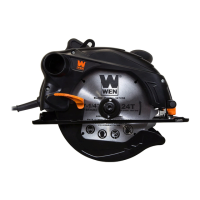SPECIFIC RULES FOR THE CIRCULAR SAW
9. DURING THE CUT. Keep hands away from the cutting area and the blade. Do not reach underneath the work-
piece. The blade guard cannot protect you from the blade protruding from the underside of the workpiece. Do not
attempt to remove cut material when the blade is moving.
10. REDUCING KICKBACK. Kickback is a sudden reaction to a pinched, bound or misaligned saw blade, causing
an uncontrolled saw to lift up and out of the work piece toward the operator. When the blade is pinched or bound
tightly by the kerf (width of cut) closing down, the blade stalls and the motor reaction drives the unit rapidly back
toward the operator. If the blade becomes twisted or misaligned in the cut, the teeth at the back edge of the blade
can dig into the top surface of the wood causing the blade to climb out of the kerf and jump back towards the opera-
tor. Take the proper precautions below to reduce the risk of kickback.
• Maintain a firm grip on the saw and position your body and arm in a way that allows you to resist kickback forces.
Kickback forces can be controlled by the operator, if proper precautions are taken.
• When a blade is binding (or when interrupting a cut for any reason), release the trigger and hold the saw motion-
less in the material until the blade comes to a complete stop. Never attempt to remove the saw from the work or
pull the saw backward while the blade is in motion or kickback may occur.
• When restarting a saw in the workpiece, center the blade in the kerf and check that the teeth are not engaged
into the material. If the saw blade is binding, it may walk up or kickback from the work piece as the saw is restarted.
Investigate and take corrective actions to eliminate the causes of blade binding.
• Support large panels to minimize the risk of blade pinching and kickback. Large panels tend to sag under their
own weight. Supports must be placed under the panel on both sides, near the line of the cut and near the edge of
the panel.
• Do not use dull or damaged blades. Unsharpened or improperly set blades produce narrow kerf, causing exces-
sive friction, blade binding, and kickback.
• The blade depth locking knob and bevel adjustment locking knob must be tight and secure before making a cut.
If the blade adjustment shifts while cutting, it will cause binding and kickback.
• Use extra caution when making a plunge cut/pocket cut (see page 14) into existing walls or other blind areas. The
protruding blade may contact objects that could cause kickback.
11. TURNING OFF THE TOOL. Blades coast after turning the saw off. Wait until the blade stops before reaching
for loose material or setting the tool down.
12. REPLACING SAW BLADE. Check the blade for chipped or broken teeth. Do not use dull or damaged
blades. Unsharpened or improperly set blades produce narrow kerf, causing excessive friction, blade binding, and
kickback. Always use blades with correct size arbor holes. Blades that do not match the mounting hardware of the
saw will run eccentrically, causing a loss of control. See “Replacing the Blade” on page 15.
13. MAKING ADJUSTMENTS. Always turn off and unplug the saw before making adjustments or changing at-
tachments. Accidental start-ups may occur if the saw is plugged in during an accessory change or adjustment.
7

